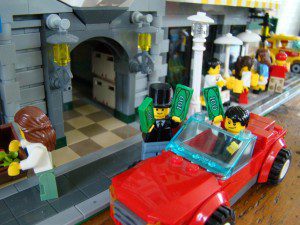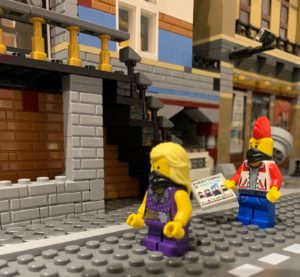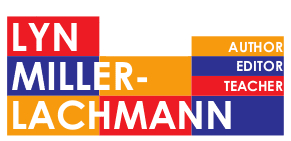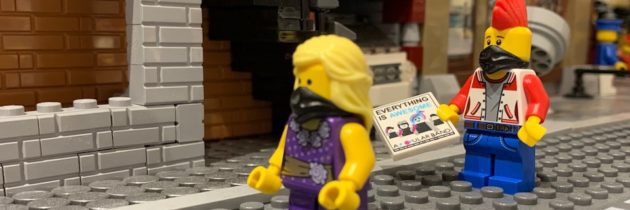Six Studs of Separation
The lockdown in New York City is now six weeks old with no end in sight. Across the country, demonstrators — many of them funded by corporate interests eager to get people back to work and to end the Covid-19 pandemic in the U.S. via the herd immunity route — have clamored for their states’ reopening. Some have brought semi-automatic weapons and Confederate flags to their events, making it appear as though all the people longing to get out of the house are right-wing extremists.
Regardless of political beliefs, nobody likes having to stay at home, wear masks outside, and stay six feet away from the next guy. Nobody likes having their favorite restaurant, beauty salon, gym, or independent bookstore closed, perhaps never to reopen. However, we’re in a situation where we have no good choices.

The red sports car — an emblem of the Midlife Crisis.
At the beginning of the lockdown, I described us as the collective protagonist, with our individual choices having life-or-death consequences for everyone in our communities. Since then, I’ve argued almost daily with my husband, who despite not being a right-wing extremist, is calling for our communities to reopen. I know he misses his movies and theater. That’s why we moved from Albany to New York City in the first place, and the last thing he wants to do is sit in a tiny apartment instead of a spacious 1920s house with a garden and have the same limited cultural opportunities. But he also made the larger point that an economic collapse fueled by the lockdown would lead to starvation, suicides, a rise in violent crime, and other life-threatening consequences. He cited research from Anne Case and Angus Deaton on “deaths of despair,” in the U.S., the result of growing inequality and hardened class lines since the 1980s.
Lockdowns have their costs. An extended period of social isolation has vast psychological consequences. Children unable to attend school for years at a time become ignorant and feral, ripe for indoctrination. When the Nazis took over Czechoslovakia after the 1938 Munich Agreement, for instance, the first thing they did was close universities and secondary schools and commandeer teens to labor in German factories. In a divided nation with fraying community ties, social isolation has frayed them further. Nowhere in the world, except in failed states torn by civil strife, do heavily armed gangs show up at the homes of political leaders, as hundreds did in St. Paul, Minnesota last week to terrorize Governor Tim Walz and his family. In that sense, the costs of lockdown are not only economic; they are also to the fabric of civilization.

Six studs of separation.
At the same time, what are the civilizational costs of opening up the country? It’s no coincidence that the right-wing extremists began their protests when it became clear that the primary victims of Covid-19 are mostly in liberal states and in liberal cities of swing or conservative states, and Black and Latino people of all ages suffer disproportionate losses. Among other victims of the virus are residents of nursing homes, inmates of prisons, and people with disabilities or chronic illnesses. The lieutenant governor of Texas, Dan Patrick, went so far as to tell people over 70 that it was their patriotic duty to risk death for their children’s and grandchildren’s economic future. Leaving aside the fact that the virus also kills younger people and leaves many of the survivors with permanent disabilities, to target a segment of the population for death is a crime against humanity that desensitizes the survivors to other crimes against humanity. Civilized societies do not condemn elderly people, ethnic and religious minorities, or people with disabilities to death. The Nazis popularized the term “useless eaters,” and we all know where that led. If an economic system requires mass death in order to survive, the fault lies with the economic system, not with the people.
So I’ll stay home even now that I can walk again, and wear a mask and stay six feet away from the next person if I do go out for a short walk (which I’ll have to do since I need to relearn to walk on uneven surfaces). I see that countries in Asia and Europe are beginning to open up, with children returning to school in split shifts. I wish we could do the same here safely, but New York City has the highest illness and death rate in the entire world, testing is nonexistent, and our health care workers have limited protective equipment thanks to the incompetence and perfidy of our national government. A better governed nation would have had less loss of life, suffering, and economic damage — would have had better choices than we do now — but here we are, trying to make the best decisions as individuals when so much has already been taken from us.







Thank you for this blog post. It speaks exactly to the way I feel. Currently, I am pursuing my MFA at VCFA. I came across your site after reading your critical essay, “Beyond Pity,” which I found extremely insightful and well-written. Thank you for your books, blog posts, and your voice. We need more such voices in the world.
Thank you for your kind words, Julie! I hope you’re enjoying your time at VCFA. It certainly changed my writing life, though I didn’t appreciate it fully until years later. Please let me know if you have questions about the thesis or disability representation in general. Some things have changed since I wrote it, including the decision by disabled activists to use disability-first rather than person-first language in order to emphasize the importance of disability in identity.